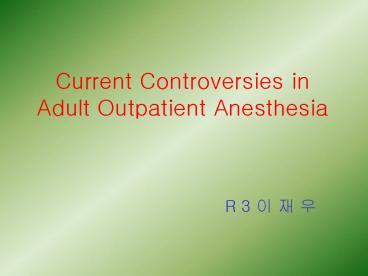Current Controversies in Adult Outpatient Anesthesia - PowerPoint PPT Presentation
1 / 25
Title: Current Controversies in Adult Outpatient Anesthesia
1
Current Controversies in Adult Outpatient
Anesthesia
- R 3 ? ? ?
2
- 1970freestanding ambulatory surgery
movement was initiated - the end of 1997
- nearly 70 of all surgeries performed in
the US will be done on an ambulatory basis
3
Value-based Anesthesia Care What Is It? What
Does It Mean to Anesthesiologists?
- Orkin
- "value-based care"
- - essentially the best patient outcome
achievable at a reasonable cost
4
The Changing Role of the Anesthesiologist The
Hows and Whys of Preoperative Evaluation
5
- Outpatient surgery growth
- Anesthesiologists demand skills choosing a good
anesthetics - Anesthesiologist physician
- Pre-op interview evaluation by a consultant
anesthesiologist can be beneficial - Lessening anxiety about op. ane
- Identify medical problems
- Initiate appropriate corrective measure
- Goal resolve pre-op problems minimizing No.
of cancellation Cx.
6
Several approach used to screen pt for ambulatory
surgery
- Facility visit
- Office or clinic visit
- Telephone interview with no visit
- Review of Health questionnaire
- Morning of operation visit
- Computer-assisted information gathering
7
Should pt. Age or ASA status influence case
selection?
- Past ambulatory surgical facilities arbitrarily
with regard to age ASA - Meridy
- could not demonstrate age-related effect
- Methodist ambulatory surgicare center
- unanticipated admission rate 1.1(gt60yr)-
0.8(overall) - Natof ASA3 no higher risk than 1,2
- FASA little or no relation bteween preexisting
disease and the incidence of periop. Cx.
8
- Outpatient surgery is no longer restricted to
young, healthy patients. - Geriatric and ASA3,4 acceptable candidates for
outpatient surgery if systemic diseases are well
controlled.
9
What laboratory tests are really needed?
- Most tests not contribute beneficially to
periop Mx. - Lab. Test possess shortcoming
- Fail to uncover pathologic condition
- Abnormalities not necessarily improve pt. Care or
outcome - Inefficient in screening
- Often not appropriately followed
- False-positive result
10
- 30billion spent were spent on pre-op test
evaluation in U.S. in 1984 - (12-18billion could be saved)
- Many facilities now determine
- pre-op test are required based on the
operative procedure and pt age, preexisting
medical disease, medical history
11
The inappropriate patientwhos OK and whos not
- Few data exist
- Anesthesiologist experience ?
- ? list of inappropriate patients?
- At the University of Chicago hospital
- distinguished several groups of patients may
not be appropriate candidates for ambulatory
surgery - -Unstable pt. Classified as ASA 3 and 4
- -malignant hyperpyrexia
- -MAO inhibitors
- -complex morbid obesity
- -acute substance abuse
- -psychosocial difficulties
12
- Discharge criteria for the 21st century
- Can short-acting, fast-emergence anesthetics
make a difference? - Do all patients really need to go to the
postanesthesia care unit?
13
- RR is no longer the cash cow in a fee-for service
system. - Increasingly important for the anesthesiologist
to accurately assess the earliest time when pt.
Can be safely sent home after surgery. - PACU
- shall be available to receive pts after
surgery and anesthesia. - all pts. who receive anesthesia shall be
admitted to the PACU - ? current standard
14
Table 1.
- Awake,alert,oriented, responsive(or return to
baseline - Minimal pain
- No active bleeding
- Vital signs stable
- Minimal nausea
- No vomiting
- If non-depol NM blockers used, can perform
5-second head tilt - SaO2 94
- On room air
15
Important lessons from short-acting,
Fast-emergence study
- Pt-bypass first-stage PACU
- Surgical center-financial saving
- Table 1? ???? second-stage recovery unit?
- Important cost savings can be achieved without
compromising patient safety after a bypass
paradigm is implemented
16
- Inhalational agents for ambulatory surgery into
the 21st century Desflurane and Sevoflurane. - Are they safe?
- Do they really make a difference?
17
- Several agents introduction
- More rapid recovery, easy titration, fewer side
effects - Two new inhalation agents
- Sevoflurane desflurane
- Lower blood-gas solubility
- Greater control of anesthetic depth and more
rapid recovery from GA
18
Desflurane
- 1.Physical properties
- -very similar structure of isoflurane
- -low solubility in blood body tissues
(?b/g 0.42) - ? rapid induction emergence
- -most characteristic feature
- high vapor pressure,
- ultrashort duration of action,
- moderate potency
19
- 2.Effects on organ systems
- A.cardiovascular
- -isoflurane? ??
- -arterial BP ?
- -CO relatively uncahanged
- -HR, CVP, pulmonary artery pressure ?
- B.resporatoy
- -RR ?, TV ?
- -pungency, airway irritation
- ? induction? salivation, breathing- holding,
coughing, laryngospasm? - ??? ? ??.
20
- C.cerebral
- -cerebral blood flow, ICP ?
- -autoregulation intact
- -CMRO2 ?
- D.neuromuscular
- -response to train-of-four tetanic
peripheral nerve stimulation ? - E.renal
- -no evidence fo nephrotoxic effect
- F.hepatic
- -no evidence of hepatic inj.
21
- 3.Biotransmission toxicity
- -minimal metabolism
- 4.CIx
- -sever hypvolemia, malignant HTN, intracranial
HTN - 5.Drug interaction
- -epinephrine
- safely administered up to 4.5 ?/?
- -nondepolazing blocking agent? ??
22
sevoflurane
- 1.Physical properties
- -halogenated with fluoride
- -excellent choice for inhalational
induciton - no pungency rapid FA
23
- 2.Effect on organ system
- A.cardiovascular
- -mildly depress myocardial contractility
- -systemic vascular resistance
- arterial BP ?
- slightly of desflurane , isoflurane
- B.respiratory
- -depress respiration
- -bronchodilator
24
- C.cerebral
- -cerebral blood flow ICP ?, CMRO2 ?
- -no seizure activity
- D.neuromuscular
- -adequate m.relaxation for intubation of child
- E.renal
- -renal blood flow slightly ?
- F. hepatic
- -total hepatic blood flow, O2 delivery? ??
25
- 3.Biotransmssio toxicity
- -metabolize similar to enflurane
- -potentila nephrotoxicity
- 4.CIx
- -sever hypovolemia,
- malignant hyperthermia,
- intracranial HTN
- 5.Drug interaction
- -no sensitization of heart to dysrhythmic effect
of epinephrine - -nondepolarizing blocking agnet? ??































